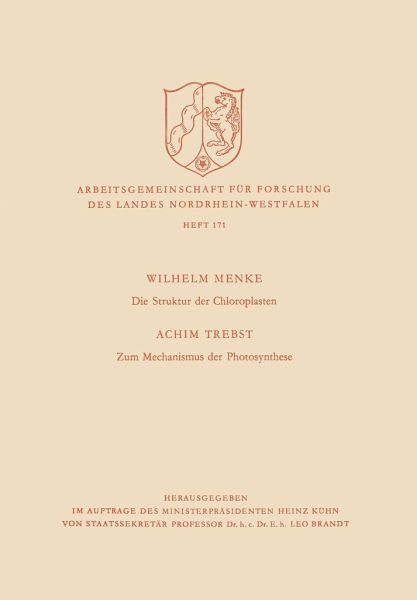
Die Struktur der Chloroplasten. Zum Mechanismus der Photosynthese

PAYBACK Punkte
0 °P sammeln!
The building elements of all photosynthetie lamellar systems are the thylakoids which in general are shaped as flattened vesicles. As shown by electronmicroscopy and X-ray small angle scattering investigations thylakoid membranes have a thickness of about 80 A. They consist of a monomolecular protein layer at the outside of the thylakoid, and of a lipid layer inside the thylakoid whieh probably is also monomolecular. The lipoprotein membrane is only stable in the presence of water indicating that there are mutual hydrophobie interactions between proteins and lipids. Within the protein layer th...
The building elements of all photosynthetie lamellar systems are the thylakoids which in general are shaped as flattened vesicles. As shown by electronmicroscopy and X-ray small angle scattering investigations thylakoid membranes have a thickness of about 80 A. They consist of a monomolecular protein layer at the outside of the thylakoid, and of a lipid layer inside the thylakoid whieh probably is also monomolecular. The lipoprotein membrane is only stable in the presence of water indicating that there are mutual hydrophobie interactions between proteins and lipids. Within the protein layer the protein particles may be arranged in a crystalline array. Both sides of the protein layer look different which is probably due to an attachment or incorporation of bigger protein partieIes on one side of the protein layer. These partieies are allocated to certain points of the lattiees. The protein partieles of the protein layer show a less dense middle zone. It was confirmed by serologieal investigations that proteins are located on the surface of the thylakoids. Three components of the electron transport system were determined on the surface of the thylakoid. Resume Les thylacoides qui epousent le plus souvent la forme de vesicules aplaties, sont les elements constitutifs de tous les systemes lamellaires photosynthetiquement actifs. Des etudes au microscope electroruque et la radiographie ont revele que l'epaisseur des membranes des thylacoides est d'env. 80 A.














